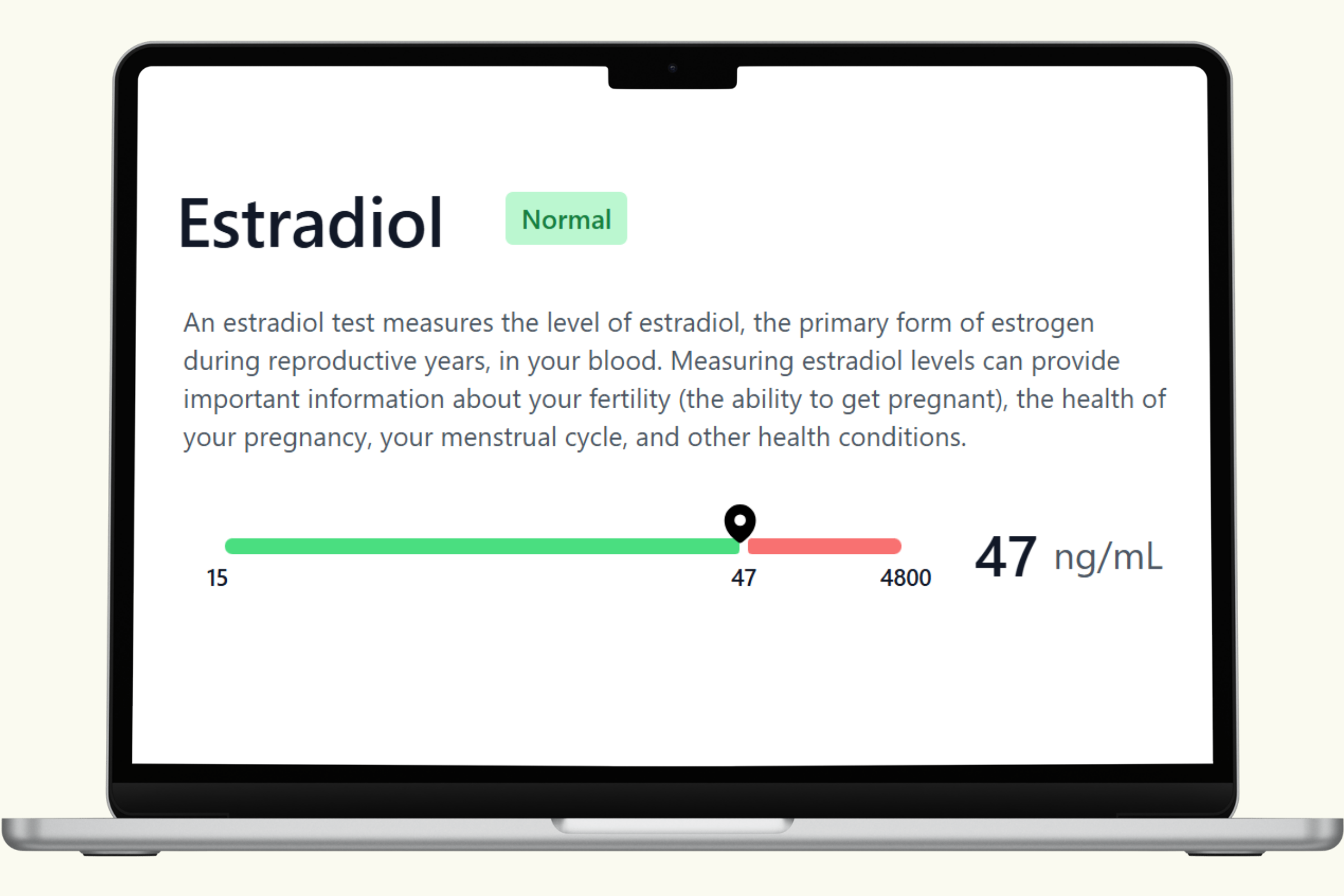Estradiol (E2) Blood Test: Understanding Estrogen’s Role in Women’s Fertility
The Estradiol (E2) Blood Test, part of the PlexusDx Women’s Fertility Blood Test, provides vital information about reproductive health, hormone balance, and overall wellness. Estradiol is the most potent and biologically active form of estrogen. While primarily produced in the ovaries, smaller amounts are also synthesized by the brain, fat tissue, bones, and immune cells. Because estrogen is central to menstrual cycle regulation, ovulation, and pregnancy, measuring estradiol is a critical step in fertility testing and hormone health evaluation.
What is Estradiol (E2)?
Estradiol belongs to the estrogen family of hormones, which are responsible for developing and maintaining the female reproductive system. Estradiol levels fluctuate throughout the menstrual cycle, peaking just before ovulation to help trigger the release of an egg. Beyond fertility, estradiol also influences bone density, weight balance, cardiovascular health, thyroid regulation, and brain function. These wide-ranging effects make estradiol a key marker not only for fertility but also for long-term health.
Why Test Estradiol?
The Estradiol Blood Test can reveal important information about ovarian function, hormone balance, and fertility potential. Doctors commonly order this test to:
- Evaluate infertility: Estradiol helps assess egg development and readiness for ovulation.
- Assess ovarian reserve: Low estradiol may suggest diminished ovarian function, while very high levels may point to ovarian hyperstimulation.
- Investigate irregular or absent periods: Abnormal estradiol levels can disrupt the menstrual cycle.
- Monitor fertility treatments: Estradiol is closely tracked during IVF and other assisted reproductive therapies to measure follicle response.
- Check for menopausal transition: Declining estradiol is one of the hallmarks of perimenopause and menopause.
Estradiol and the Menstrual Cycle
Estradiol levels change predictably throughout a woman’s cycle, making timing of the test important for accurate interpretation:
- Follicular phase (early cycle): 20 – 350 pg/mL
- Mid-cycle peak (around ovulation): 150 – 750 pg/mL
- Luteal phase (after ovulation): 30 – 450 pg/mL
- Postmenopause: <20 pg/mL
Functional or “optimal” fertility testing often focuses on day 3 estradiol levels. Ideally, these should be under 80 pg/mL. Higher levels early in the cycle can suggest reduced ovarian reserve or premature ovarian aging.
How Estradiol Affects Fertility
Estradiol plays several critical roles in fertility:
- Follicle development: Rising estradiol stimulates ovarian follicles and supports egg maturation.
- Endometrial preparation: Estradiol thickens the uterine lining, making it receptive to embryo implantation.
- Triggering ovulation: High estradiol levels signal the brain to release a surge of luteinizing hormone (LH), leading to ovulation.
- Luteal phase support: Balanced estradiol ensures proper progesterone function after ovulation.
Both excessively high and abnormally low estradiol can negatively impact fertility, either by impairing ovulation, reducing egg quality, or preventing implantation.
Estradiol Beyond Fertility
Estradiol’s effects extend well beyond reproductive health. Normal levels contribute to:
- Bone strength: Protects against bone loss and osteoporosis.
- Metabolic balance: Helps regulate body weight and fat distribution.
- Brain function: Supports cognition, mood, and memory.
- Cardiovascular health: Aids in maintaining healthy cholesterol and blood vessel function.
This makes estradiol a key biomarker not only for fertility but also for lifelong health monitoring.
Symptoms of Estradiol Imbalances
- Low estradiol: Irregular or missed periods, hot flashes, vaginal dryness, low libido, mood changes, poor bone density.
- High estradiol: Heavy or irregular bleeding, bloating, breast tenderness, weight gain, mood swings, ovarian cysts.
Specimen Collection with PlexusDx
The Estradiol Blood Test in the PlexusDx Women’s Fertility Panel uses an at-home dried blood spot collection with an ADX card. This simple process involves a quick finger prick, applying a few drops of blood to the card, and mailing it back in the pre-paid envelope. Results are processed quickly, with clear and actionable insights delivered securely to you.
Benefits of Estradiol Testing with PlexusDx
- Convenient at-home collection: No need for clinic visits or venipuncture.
- Part of a comprehensive fertility panel: Estradiol is measured alongside FSH, LH, TSH, and other hormones for a complete fertility picture.
- HSA/FSA eligible: Use pre-tax dollars to cover the test.
- Empowers informed decisions: Results guide meaningful conversations with your healthcare provider.
What to Do if Your Estradiol Levels Are Abnormal
If estradiol levels fall outside the expected range, your healthcare provider may recommend:
- Further testing: Additional hormone tests (FSH, AMH, LH, progesterone) or ultrasound imaging of the ovaries.
- Fertility treatment: Adjusting timing of ovulation induction, IVF protocols, or hormone therapy.
- Lifestyle support: Balanced nutrition, exercise, and stress reduction can help regulate hormone levels.
- Medical management: Addressing underlying conditions like PCOS, ovarian insufficiency, or thyroid dysfunction.
Conclusion
The Estradiol (E2) Blood Test is a cornerstone of fertility and reproductive health evaluation. By measuring the most active form of estrogen, this test provides valuable insights into egg development, ovulation, uterine health, and overall hormone balance. With the convenience of at-home collection and clinically reliable results, the PlexusDx Women’s Fertility Blood Test gives women the knowledge they need to optimize fertility and take control of their reproductive journey.

Share:
Follicle-Stimulating Hormone (FSH) Blood Test
Free T4 Blood Test